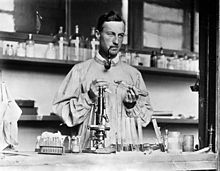Herbert Durham
| Herbert Durham | |
|---|---|

Herbert Durham in the Department of Pathology, Cambridge University.
Wellcome Images |
|
| Born | 30 March 1866 |
| Died | 25 October 1945 (aged 79) |
| Nationality | British |
| Fields | Bacteriology, Pathology, Zymology |
| Institutions | University of Cambridge |
| Alma mater |
University of Cambridge Guy’s Hospital, London |
Herbert Durham DSc (Cantab), MB, BC, FRCS, ARPS (30 March 1866 – 25 October 1945) was a British physician and distinguished scientist.
Herbert Edward Durham was born 30 March 1866, the son of Arthur E. Durham, Senior Surgeon to Guy’s Hospital. He married Maud Lowry, daughter of Capt. Harmer of 81st Regiment.
Durham was educated at University College School, London from 1883–84; King’s College, Cambridge from 1884; and Guy’s Hospital, London.
In 1904 he was awarded a John Lucas Walker Studentship in Pathology, a scholarship given by the University of Cambridge for original pathological research.
He was Assistant Demonstrator in Histology from 1884–89, then House Surgeon at Guy's Hospital, London from 1889-95.
From 1895-96 he worked at the Hygiene Institute, Vienna where he was associated with Professor Max von Gruber in the discovery of agglutination of bacteria. In 1897 he developed an agglutination reaction for diagnosis of typhoid fever, which then was called the Grubler-Durham reaction, subsequently known as the Widal reaction; and also created "Durham tubes" for measuring the amount of gas produced in the bacterial colonies, which are still used universally in microbiology laboratories.
From 1896-98 he was a working Member of Tsetse Fly Disease Committee of the Royal Society.
In June 1900 under the auspices of the Liverpool School of Tropical Medicine and accompanied by fellow eminent Cambridge parasitologist , Dr Walter Myers, Durham led the Yellow Fever Expedition to Brazil. In 1881 the Cuban epidemiologist Dr Carlos Finlay was the first to theorise that yellow fever was transmitted by mosquitoes, but this remained unproven in the wider scientific community. While en route to Brazil they visited the U.S. Naval Hospital in Washington where they met U. S. Surgeon General George Miller Sternberg who is considered the first U.S. bacteriologist, and then proceeded to Havana where they met Dr Finlay and his co-workers on 25 July 1900, and also the U.S. Army Yellow Fever Commission, led by Dr Walter Reed, which subsequently confirmed Dr Finlay’s theory. Among Reed’s team was bacteriologist Dr Jesse Lazear who died a month later on 26 September aged 34 while investigating the disease.On 24 August Durham and Myers arrived in Pari (modern day Belem) in the northern state of Pará, Brazil, where they established a laboratory to study the transmission of the disease and were among the first to establish its transmission by mosquitoes. Durham and Myers were aware of the risks that they were taking; however, on 16 January 1901, after conducting the fourteenth autopsy on victims of yellow fever both men found they were themselves infected. They were transferred to the Domingos Freire Isolation Hospital in Pari where Durham recovered but Myers died four days later, aged 28. In his subsequent report Durham deduced that they had both been infected through mosquito bites.
...
Wikipedia
